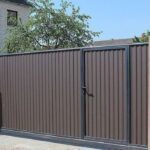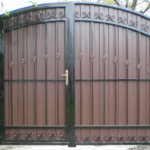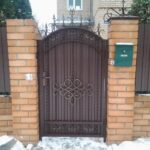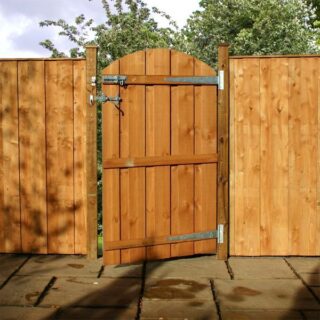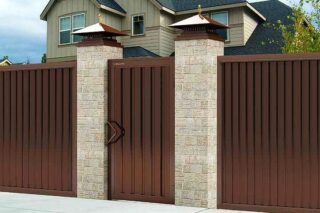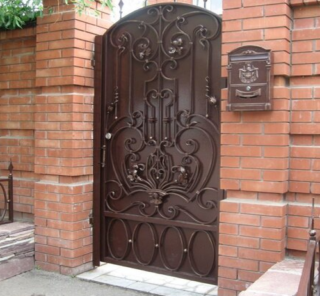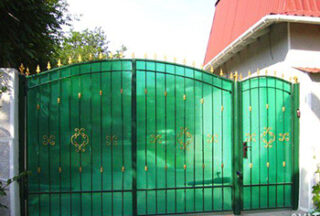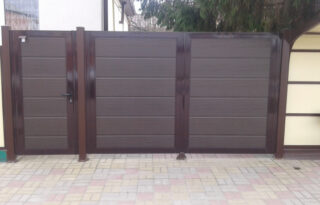In the fencing of private land tenure, a door for exit and entry is made. Site owners often make a gate with their own hands from metal and wood in order to save money and create an original product that is unlike others. The filling of the sash is chosen so that it is in harmony with the material of the gate, pillars, fence and spans.
Basic requirements for a wicket
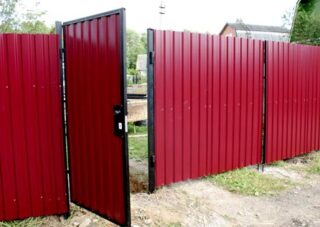
The designs of the passage in the fence are varied, the number of options increases due to the use of materials that are opposite in technical characteristics.
There are general requirements for all wickets:
- the dimensions are chosen so that people of different sizes can freely pass through the opening;
- opening should not interfere with the usual flow of passers-by, for example, if there is a sidewalk nearby, the gate swings open into the yard;
- it is advisable to put pendulum awnings so that you can open the sash from both sides;
- the canvas should open easily so that a passing person does not expend effort;
- the lock and the handle are fixed at the height of the bent arm in a convenient place.
Internal opening is recommended in order to reduce the visibility of the open sash from the street and to reduce the risk of entering the courtyard. In regions with abundant snow, the canvas at the bottom is cut in height by 15 - 25 cm, a gap is obtained to open the door in case of drifts. The hinges are made so that they cannot be damaged from the outside, and the sash is made strong and resilient against impacts.
Design features
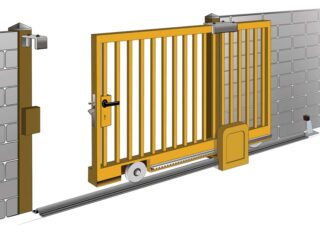
The scheme has support pillars, a canvas embedded in a frame from a corner, a square, a pipe. The frame of the sash is set on hinges, which are attached to the posts on the logs by means of embedded metal elements (brick columns) or welded (iron supports).
You can build a separate gate in the garden fence or make an opening opening in the body of a garage door.
By the type of opening, wickets are distinguished:
- swing;
- sliding;
- automatic.
Swinging arms are classified as cheap budget options, since the structure is easy to manufacture, install and operate. It is such a gate for a metal fence that is built into the gate, as a result of the combination, the number of support posts is reduced. Hinges are welded to vertical elements, awnings are made of polymer or metal.
Sliding includes a canvas, roller mechanism, lower and upper parallel rails. The sash moves strictly horizontally, so the base is carefully leveled. The disadvantages include the need to build a foundation into which the strips are mounted. The advantages include compactness, since the wicket can be opened regardless of the presence of free space nearby.
The machines are installed for sliding and swinging options, the canvases are powered by a remote control.
Wicket drawing
Before making a wicket, a sketch is created to visually see the structure of the frame, crossbeams and the option of filling the sash.
Common versions of drawings:
- Gate with a wicket inside. The height of the passage is made standard - 2 meters, the door leaves are fixed in the frame of their square 20 x 40 mm. The frame of the canvases is attached to the posts with a section of 60 x 60 mm. Rigidity is created by horizontal bars. In the opening of one gate leaf, a frame for the wicket is made.
- Swing gates with a built-in door, but at the top they make a horizontal crossbar to increase rigidity. In a structure with a width of 4 meters, transport and people pass through.
- Separate gate in the cottage railing with diagonal braces made of square pipe. It is important to choose the right arrangement of stripes and pattern. Make diagonals from the corners to the middle or braces at the corners of the canvases. Weighting the sash makes it necessary to strengthen the racks. They are made from a square tube 80 x 90 mm.
According to the drawing, the dimensions of the pillars, horizontal and diagonal parts are determined, the volume of the required material is calculated.
Support materials
The posts for the manufacture of wickets are made of a round or square steel pipe with massive shells (from 3 mm). A round section is inconvenient in welding, it is inconvenient to attach hinges and constipations to it. The square is easier to connect, it is easier to fix hardware to flat walls. Sometimes a metal profile in the form of a corner, channel is attached to the profile pipe by welding, then the filling of the sash is obtained in the frame.
Wooden posts for supports are used if a fence is built from boards, bars or other lumber in the country. More often, the racks are coniferous timber impregnated with protective compounds. Processing protects wood from fungus, moisture, bugs and fire. Areas in the ground are also protected with a layer of roofing material to reduce the risk of rotting.
There are combined options when the fence is made of wood and wood is used to fill the sash, but the racks for hanging the sash are made of metal. These can be pipes installed in the ground and concreted if the soil is not prone to heaving.
Sash materials
When choosing the type of sash filling, the owners are guided by the design features and requirements for the wicket. Sometimes it is required to completely hide the inner space of the courtyard; in other versions, the canvas plays an aesthetic role in the composition of the entrance group. In this case, the choice of material is determined by the exterior of the house, the landscape of the garden plot.
Metal and wood are classic materials, but other types are also used:
- corrugated board;
- forged lattices;
- polycarbonate;
- sandwich panels.
Each of the materials differs in properties, appearance, so the choice is made on acceptable variations in terms of characteristics and price. They take into account the fact that with a beautiful appearance, the gate also protects the yard from uninvited guests, therefore the canvas must be strong, and the hinges and locks must be reliable.
Wood
Benefits of using:
- environmentally friendly material;
- ease of processing and the ability to make a do-it-yourself fence gate;
- light weight, sufficient strength;
- there is no need to use complex equipment during assembly.
Wood is classified as a moisture-absorbing material. Because of this, the products rot, microorganisms grow inside, and bugs spoil the wood. The canvas can deform when moistened and dried, and the racks can lose their verticality. Wood is subject to burning.
Before making the gate, the material is impregnated with antiseptics and agents that increase the fire resistance. During operation, the structure is painted, the coating is regularly updated.
Corrugated board
The corrugated profile is suitable as filling in the frame of the wicket due to the following qualities:
- zinc or polymer layer protects against aggressive substances in the atmosphere, protects metal from corrosion;
- a large selection of colors, textures;
- weighs a little, does not make the canvas heavier.
The disadvantages include the susceptibility to corrosion of the cut points, so the sheets cannot be processed with a grinder so as not to damage the edges. Circular saws are used. The corrugated board is fixed to steel frames with self-tapping screws, rivets, bolts, hardware must have a galvanized coating. Before installing rivets and bolts, holes are drilled in the metal, for self-tapping screws, the diameter of the drill is taken by 0.5 - 1 mm of the fastener.
Forged items
Products with forged inserts are durable due to special processing and painting, they are durable and resistant to wear. Elements are combined with polycarbonate, wood, profiled sheet, granite, marble, therefore they are used in the construction of their various materials.
Sometimes artistic ligature is placed as a filling of a metal frame without the use of other inserts. Forged elements are used to decorate a wicket made of a steel mesh netting. The disadvantage is the large weight of the wicket with forged parts, which requires a reinforced base. Products are made to order, so they are expensive.
Polycarbonate
The varieties are produced:
- cellular;
- monolithic.
Cellular is represented by a material with internal voids, a distinction is made between single-chamber and multi-chamber polycarbonate. The partitions inside are X-shaped or F-shaped. The thickness of the sheets ranges from 4 to 10 mm.
Lightweight material is easy and quick to assemble, sheets are relatively inexpensive. Plastic material does not warp under the influence of the sun, moisture. With heating and cooling, it changes size, therefore, when fixed, they give small gaps for mobility. Available in transparent or translucent with various shades.
Monolithic polycarbonate is presented on the market with solid plates that look like ordinary glass. Sheets with a thickness of 2 - 15 mm are characterized by high impact resistance. The filling in the gate will be transparent, even if the material is selected with a shade. Does not lose its properties at outdoor temperatures from -40 to + 120 ° C.
Sandwich panels
The outer layer is made of material:
- galvanized steel, while corrosion resistance depends on the thickness of the coating;
- aluzinc - compounds of zinc (43.4%), aluminum (55%), silicon (1.6%), the material reflects ultraviolet light;
- plastisol or modified polyvinyl chloride, the filling retains its quality even in an unfavorable environment;
- polypropylene, polystyrene which is characterized by increased rigidity;
- polyester, purala, resistant to the vagaries of the weather;
- moisture resistant hardboard with increased weight.
For internal insulation in sandwich panels, basalt mineral wool, polyurethane foam, fiberglass plates are used. They put extruded polystyrene foam, polypropylene.
Self-assembly procedure
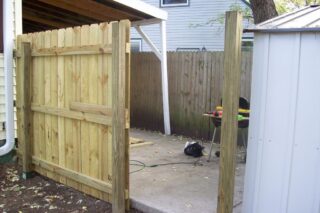
First, the pillars are installed. A hole is dug up to one meter deep, 15 cm of crushed stone is poured onto the bottom. The vertical support is set on a plumb line, fixed with crushed stone, you can use broken brick. The hole is poured with concrete. The frame to the post can be fixed on the seventh day.
To make the wicket correctly, take welding and a 40 x 20 mm square pipe with a 3 mm wall. Measurements for the frame are made at the installation site between the embedded parts.
Operating procedure:
- cut off two transverse elements and two racks;
- the crossbars are tacked by welding to the mortgages, having previously checked the horizontal position;
- racks are welded to them at an angle of 90 °, the seam is performed along the perimeter around the pipe;
- check the squareness, attach the loops.
The canopies are placed vertically, placed on the same axis, the lower one is attached first, then the upper one. After that, the potholders are removed, which held the canvas in an upright position, and the sash should open. For rigidity, braces are placed in the frame of the wicket, which are also made of a square. At the installation site of the lock, a pipe is reinforced.
The open ends of the pipes in the product are welded, sealed with silicone, or suitable stoppers are found. Then the metal is ground at the welding points, primed and painted.
How to choose a locking device
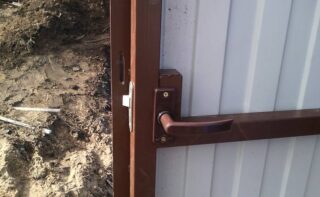
The castle is affected by rain, the structure is covered with ice in frost after wet weather. The best option is the mortise device, which is distinguished by its reliability.
There are other types of locks:
- Hinged. Used in summer cottages, installed on any canvas and box. It does not differ in reliability.
- Rack. The mechanism includes a bolt that moves along hinged hinges. Low security.
- Overhead. Installed by welding, reliable mechanism.
- Electromechanical. Consists of a shutter device and a control panel with keys. Requires electricity connection.
Electronic locks are used, while the device operates from a magnetic key. It used to be considered reliable, but modern methods help to hack the device.
Radio wave locks work like a car alarm, today they are reliable. Such devices are installed by specialists, independent installation will not work.

